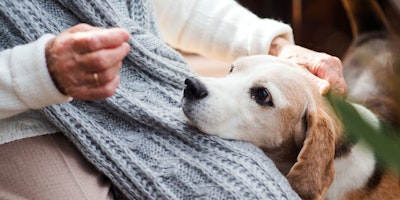
When Is a Dog Considered a Senior?

In general, most dogs are considered “senior” around age seven. Dogs and people have different lifespans, though, making it hard to know exactly when your dog qualifies as a “senior” dog.
While senior dog age depends on factors like breed and size, it’s important to look for other signs your dog is approaching their senior years. This life stage brings on the risk of age-related health challenges, as well as new opportunities to optimize nutrition, like switching them over to a senior dog food.
To help you better understand your dog’s life stage, here are some tips for spotting whether or not your dog has entered his golden years.
Pay Attention to Skin & Coat
When is your dog considered a senior? One clue is the onset of grey hair, most commonly on their muzzle and around their eyes. Like people, dogs grey at all different ages, so it’s important to look for other signs as well.
As dogs age, their digestive systems are less efficient in digesting and absorbing nutrients from their meals, such as fats and other skin-essential nutrients. This change in their digestive health can cause them to develop dryer, coarser hair, and their coat may start to thin. Other things you may notice are wrinkles on their skin and brittle texture to their toenails.
Monitor for Hearing & Vision Changes
Older dogs often experience a gradual loss of hearing. If your dog is less responsive to your commands—or stops responding altogether—they may not be hearing you as well. This could also be due to cognitive changes and them not understanding what you’re telling them.
Meanwhile, many older dogs develop nuclear sclerosis (a thickening of the lens), cataracts and other eye problems. Watch closely to see if your dog is bumping into things while they walk or has trouble locating a toy in dim light. Check their eyes periodically for cloudiness, which is a clear sign of cataracts and can be a result of diabetes. Talk with your veterinarian if you notice any vision changes.
Watch for Reduced Mobility
Senior dogs might show reduced mobility. The early stages of osteoarthritis may be one of the underlying reasons for reduced mobility. Look for common symptoms like limping, walking slowly, refusing to walk up or down steps or lack of appetite.
More subtle signs of aging can include stiffness in the morning or after a nap. You may also see atrophy in their muscles (or shrinking). This can result from disuse and also a decreased absorption of nutrients like protein.
Signs of Age-Related Health Problems in Dogs
It’s important to remember that age is not a disease. Certain physical or behavioral changes can be age-related, however. Pay attention to behavioral changes like disorientation, reduced social interaction, loss of training, changes in the sleep-wake cycle, pacing, confusion, barking or crying at night, lack of appetite and sudden aggression. These can be signs of many problems, whether physical or cognitive. Part of caring for older dogs is monitoring these changes and consulting your veterinarian when issues like these arise.
What Should I Do if I See These Changes in Behavior?
The first important step in elderly dog care is paying attention to and taking note of what you see. These changes can be subtle and happen gradually over time, making them hard to spot. The more you can identify problems early on, the better your chances of getting your dog proactive care. Consult your veterinarian as soon as a problem surfaces so you can get the most accurate diagnosis and prompt treatment. Also, most veterinarians encourage twice-yearly exams for senior dogs.
When Is a Dog Considered Elderly?
People talk about senior dogs, but how old is a senior dog, exactly? Generally, a dog is considered a senior once they reach the age of seven—or six in larger breed dogs. Around this age, there’s a change in brain activity and structure. That said, most dogs may live well into their teens.
Knowing how to care for a senior dog and providing them with the proper nutrition can help your dog continue to thrive and live many happy years with you and your family. Discover more about dogs and get tips from our experts on our Pet Expertise page.
Related articles


Be Rewarded for Your Purina Purchases
Earn and redeem points for Purina products with myPurina app.

